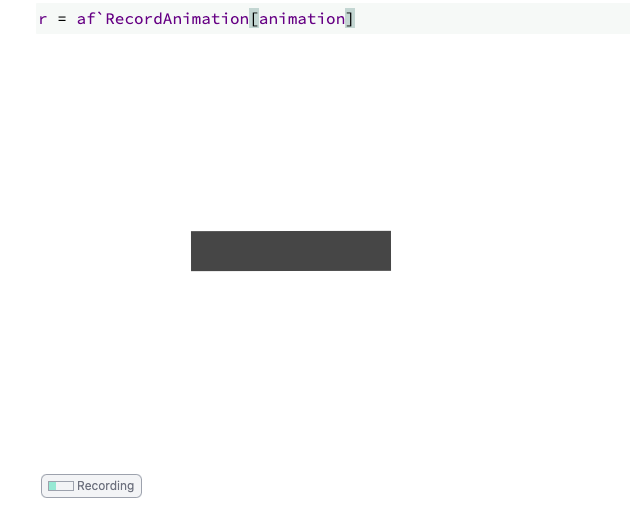Recording
Any animation sequence can be rendered to the sequence of images. Since graphical canvas can include a mixture of an arbitrary expressions containing HTML elements, SVG, WebGL canvas we rely on the direct render of Chromium Engine on-page:
- You keep the notebook open (probably fullscreen)
- Animating is played lively at lower speeds to achieve higher frame rates
- Chromium is taking screenshots of the area of the scene and saves them on the disk
warning
This feature is only available for WLJS Notebook desktop application
Tips
- Use
PauseAsyncwithsceneobject provided
...your timeline
❌ PauseAsync[3] // Await
✅ PauseAsync[scene, 3] // Await
This allows to lock the time with the frame rate
How to record?
Let's try with a simple example
Step 1
Import a library and define an animation timeline:
Needs["AnimationFramework`"->"af`"];
timeline = AsyncFunction[scene, Module[{d},
d = af`AddTo[scene, {
Opacity[#o],
Translate[
Rotate[
Rectangle[{-0.5,-0.1}, {0.5,0.1}]
, #r]
, #c]
}, {
"o" -> 0.,
"r" -> 0.,
"c" -> {0,0}
}];
af`Animate[scene, d, {"o" -> 1.0,"r" -> 3.14}, "Ease", 1.0] // Await;
PauseAsync[scene, 0.4] // Await;
af`Animate[scene, d, {"c"->{0.5,0.5}}, "Ease", 1.0] // Await;
af`Animate[scene, d, {"c"->{-0.5,0.5}, "r"->4.2}, "Ease", 1.0] // Await;
af`Animate[scene, d, {"c"->{0.5,-0.5}}, "Ease", 1.0] // Await;
af`Animate[scene, d, {"c"->{0.,0.}, "o"->0., "r"->0}, "Ease", 1.0] // Await;
af`Remove[d];
]];
Step 2
r = af`RecordAnimation[animation, ImageSize->Large, FrameRate->60];
To start recording - evaluate r and resize the notebook to fit the render window:
r

Step 3
Once the rendering has been finished, you can see the exported series:
r["OutputDirectory"] // SystemOpen
Step 4 (Optional)
Make a video using Wolfram Standard library
af`RecorderToVideo[r]